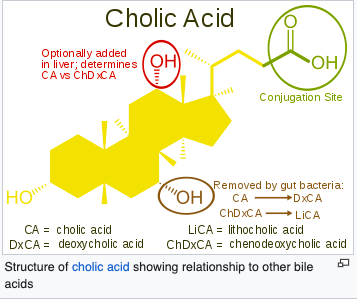Bile acid
- TTerms:
- primary bile acid
- second bile acid
- conjugated bile acid
- non-conjugated bile acid
- Bile acids are a family of steroid molecules. that are synthesized in the liver from cholesterol and are important for digestion and absorption of dietary fats.
- Bile acids are amphipathic, which means they have both hydrophilic (water-loving) and hydrophobic (water-repelling) properties, allowing them to interact with and solubilize dietary fats in the intestine.
Cholesterol


Primary bile acid
- primary bile acid produced in liver, from cholesterol
- major primary BA: cholic acid (7th, 12th -OH), chenodeoxycholic acid (7th -OH)



Secondary bile acid
- happlend in the lumen of the intestine
- modififed by microbiota: deconjugation, dehydroxylation, dehydrogenation, and epimerization
- sometimes may be partially dehydroxylated
- e.g., DCA, HCA, HDCA, LCA, ωMCA and MDCA


Conjugated bile acid
- Prior to secreting any of the bile acids (primary or secondary, see below), liver cells conjugate them with either glycine or taurine, to form a total of 8 possible conjugated bile acids. These conjugated bile acids are often referred to as bile salts.
- Most common conjugation: glycine or taurine.
- Modify PH
Unconjugated bile acid
Bile acid metabolism
Bile acid metabolism is the process by which bile acids are synthesized, conjugated, secreted into the bile, and ultimately metabolized and eliminated from the body. Bile acids are synthesized in the liver from cholesterol through a series of enzymatic reactions, and then conjugated with either glycine or taurine to form bile salts, which are then secreted into the bile ducts and stored in the gallbladder.
When dietary fats are ingested, the gallbladder releases bile into the small intestine, where bile salts help to emulsify and solubilize the fats, allowing for their efficient digestion and absorption. After performing their digestive functions, bile acids are either reabsorbed in the ileum and returned to the liver through the portal vein, or eliminated in the feces.
In the liver, bile acids are subject to several metabolic pathways, including reconjugation with glycine or taurine, sulfation, glucuronidation, and oxidation. These processes can alter the physicochemical properties of bile acids, affecting their solubility, toxicity, and signaling properties.
Disorders of bile acid metabolism can lead to a range of clinical conditions, including cholestasis, gallstone disease, nonalcoholic fatty liver disease, and various liver and gut diseases. Therefore, understanding the regulation and function of bile acid metabolism is an important area of research in both basic and clinical sciences.
Bile acids are conjugated with either glycine or taurine in the liver to form bile salts, which are secreted into the bile ducts and stored in the gallbladder. When food enters the small intestine, the bile salts are released into the duodenum to aid in fat digestion and absorption. Most of the bile salts are reabsorbed in the ileum and returned to the liver via the portal vein in a process called the entero-hepatic circulation.
Bile acids also play a role in regulating lipid and glucose metabolism, inflammation, and immunity. Dysregulation of bile acid synthesis, transport, or metabolism can lead to liver and gastrointestinal disorders, such as cholestasis, gallstones, and inflammatory bowel disease.
